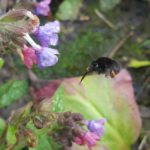Track expansion in our latest solitary bee arrivals
The latest two solitary bees to arrive in Ireland are the Ivy Bee (October 2021) and the Hairy-footed Flower Bee (March 2022). Please keep an eye out and email a photograph if you think you’ve spotted them. It will be very useful to track their expansion across Ireland in the coming years
Anthophora plumipes (Hairy-footed Flower Bee)



Information:
- First spotted in Dublin City on the 27th March 2022
- If you spot this bee, please send a photograph for validation so that we can track it’s expansion in Ireland in coming years
- Large bumblebee-sized species
- The female resembles a small, black bumblebee with orange-red hairs on the hind leg.
- The male has extensive yellow markings on its face and a very long fringe of hairs along the lower half of it’s middle leg.
- Often one of the first bees to emerge from hibernation – found from early March to late May.
- Often nests in the soft mortar in old walls. Occasionally it will nest on bare clay on the ground.
- Will visit a range of flowers but particularly likes Lungwort
- Common and widespread in much of England and Wales, especially in towns, cities and villages.
Colletes hederae (Ivy Bee)

Information:
- First spotted at the Raven Nature Reserve in Wexford in October 2021. A 2022 survey found that it has now expanded as far north as Brittas Bay in Wicklow.
- If you spot this bee, please send a photograph for validation so that we can track it’s expansion in Ireland in coming years
- Was recorded as new to Britain in 2001. Has since spread across much of southern England and into south Wales, where it is now extremely plentiful in some coastal localities.
- Very late flight period. It is the last solitary bee to emerge each year and is on the wing from early September until early November.
- Honeybee sized but with clear pale bands on the abdomen
- Look for the bee on large stands of flowering Ivy
